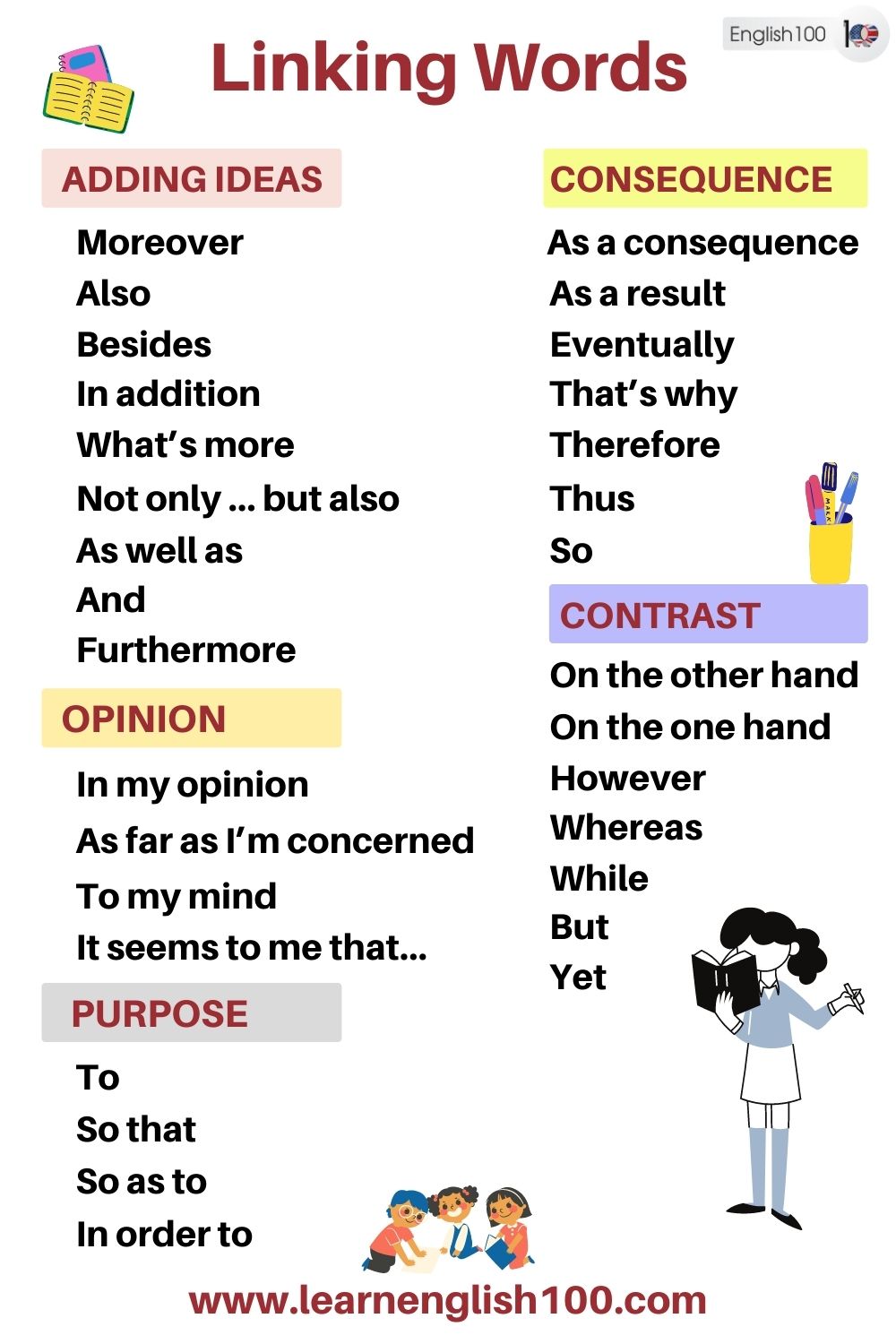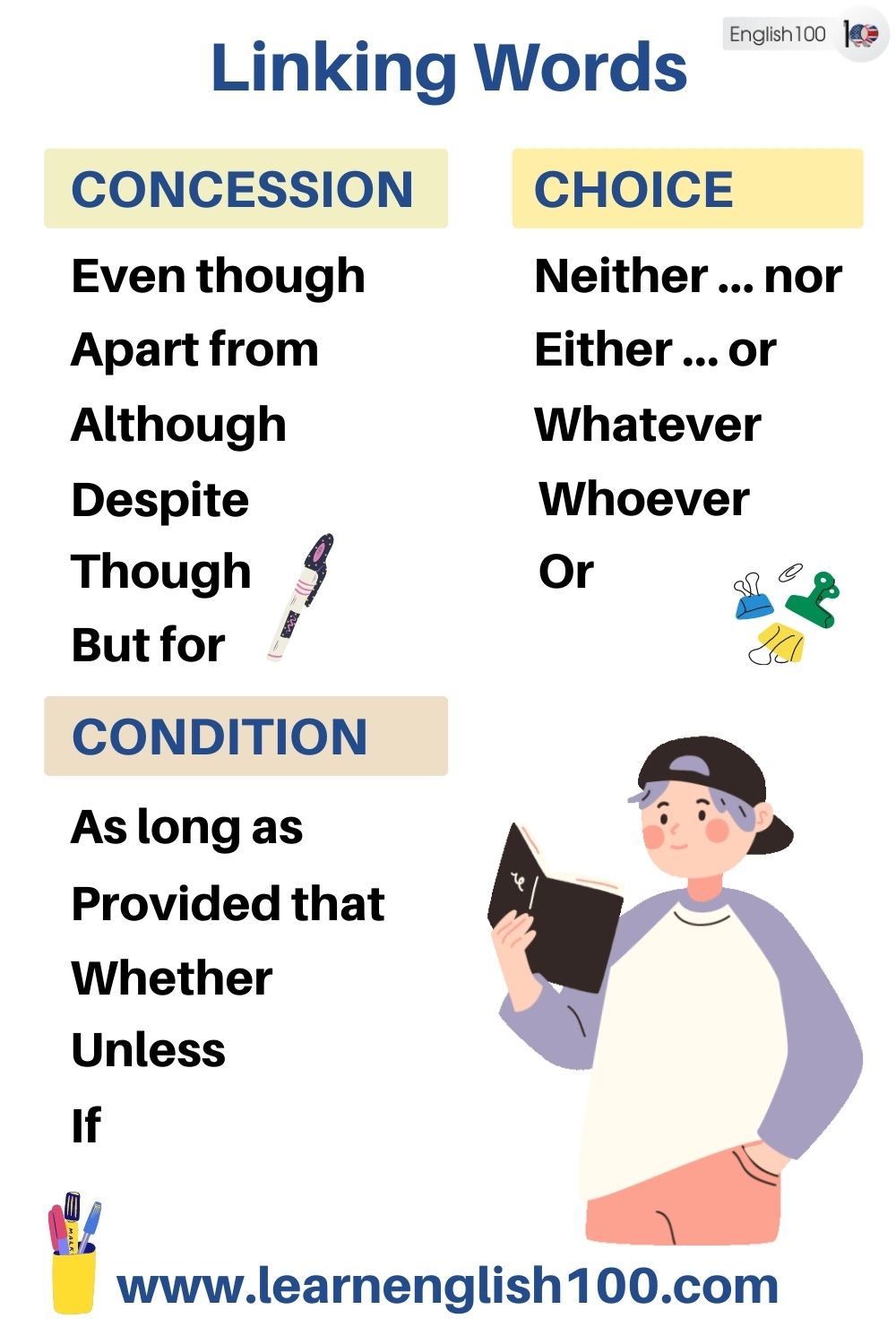

The Power of Linking Words
Linking words, also known as transition words or connectors, are an indispensable element of effective writing. They serve as linguistic bridges that connect sentences, paragraphs, and ideas, facilitating the smooth flow of information and enhancing the overall coherence of your text. In this article, we’ll explore the importance of linking words in written communication and provide a comprehensive guide on how to use them effectively.
Common Linking Words and Their Functions
ADDING IDEAS
We need to present more than one argument to withstand the attacks on our points. To add more points, we have to possess the power to add them.
Moreover
Also
Besides
In addition
What’s more
Not only … but also
As well as
And
Furthermore
OPINION:
To present our opinions which should be built on Facts.
In my opinion
As far as I’m concerned
To my mind
It seems to me that…
CONSEQUENCE
In order to illustrate the consequences of a certain event or action.
As a result
Thus
So
Therefore
As a consequence
Eventually
That’s why
CONTRAST
Presenting a contrast can be very helpful in building your case.
However
But
Yet
Whereas
While
On the one hand
On the other hand
CONCESSION
Transform the negative into a positive aspect through the power of concession.
Even though
But for
Despite
Apart from
Although
Though
PURPOSE
Be clear in regard to your purpose in whatever you do and especially in writing. Be precise!
To
So that
So as to
In order to
CONDITION
To add a condition to your presentation, use any of the following words.
As long as
Unless
If
Provided that
Whether
CHOICE
To present the audience with a choice, we’ll help you through this great list of words that’ll make clear that not all options are on the table.
Or
Whatever
Whoever
Neither … nor
Either … or
Words can connect people from different places, or bind them together in a shared experience that brings meaning to our lives. There is something particularly powerful about a word—it gives a new sense of purpose and a fresh start for what was once an idea. However, what is there to bind words or sentences together?
Using Linking Words Effectively
To use linking words effectively in your writing:
Choose Appropriate Words: Select linking words that are contextually relevant and appropriate for the relationship you want to convey.
Use Variety: Avoid overusing the same linking words. A variety of connectors can make your writing more engaging.
Consider Placement: Place linking words strategically to ensure the logical flow of your text. They can appear at the beginning, middle, or end of sentences.
Practice: Familiarize yourself with a range of linking words and practice incorporating them into your writing to improve your proficiency.
The Role of Linking Words
Linking words play several critical roles in writing:
Transition: Linking words help readers transition between ideas, concepts, or arguments within a text. They signal shifts in thought, guiding readers through the logical progression of your writing.
Coherence: Linking words contribute to the coherence and cohesion of a text. They ensure that sentences and paragraphs are connected logically, making the content easier to follow and understand.
Emphasis: Linking words can be used to emphasize key points, ideas, or arguments. By strategically placing them, you can draw attention to essential information.
Contrast: Linking words also facilitate the expression of contrasting ideas or opinions, allowing writers to present balanced and well-rounded arguments.
Linking words help link sentences to other sentences and paragraphs to other paragraphs. These linking words help to: increase cohesion in your writing by connecting your ideas. add clarity to your writing so you say exactly what you want to say. 1
FAQ
What is the role of linking words in a paragraph?
The role of linking words, also known as transition words or connectors, in a paragraph is to enhance its coherence and flow. Linking words serve as bridges that connect sentences and ideas, guiding readers through the text and making it more comprehensible and organized. Here are the key roles of linking words in a paragraph:
Coherence and Unity: Linking words help maintain coherence and unity within a paragraph. They establish logical connections between sentences, ensuring that the ideas presented relate to one another and contribute to the overall topic or argument.
Smooth Transitions: Linking words provide smooth transitions between sentences and ideas. They prevent abrupt shifts or jumps from one thought to another, making the reading experience more comfortable and enjoyable.
Logical Progression: Linking words assist in creating a logical progression of ideas within a paragraph. They help readers follow the author’s thought process and understand the sequence of information or events being presented.
Emphasis: Linking words can be used to emphasize particular points or ideas within a paragraph. By strategically placing words like “indeed,” “in fact,” or “especially,” writers draw attention to important information.
Contrast and Comparison: Linking words facilitate the expression of contrasting or comparing ideas. They allow writers to highlight differences or similarities, helping readers grasp the nuances of the argument.
Cause and Effect: Linking words indicate cause-and-effect relationships between ideas or events. They make it clear why something is happening as a result of a previous statement.
Exemplification: Linking words are useful for providing examples or illustrating points. They help clarify concepts by offering concrete instances.
Concluding and Summarizing: Some linking words are used to signal conclusions or to summarize the main points of a paragraph. They provide closure and help readers understand the key takeaways.
Continuation: Linking words such as “furthermore,” “moreover,” and “additionally” indicate that the writer is adding more information to support or expand upon the current point.
Transitioning to the Next Paragraph: Linking words at the end of a paragraph can prepare the reader for what’s coming next in the text, ensuring a smooth transition to the following paragraph.
In essence, linking words act as guides for readers, leading them through the paragraph in a structured and coherent manner. They create a clear and organized flow of information, making the writer’s message more accessible and persuasive. Effective use of linking words is a key component of strong and well-structured writing.
Is often a linking word?
No, “often” is not a linking word or a transition word like “however,” “therefore,” or “moreover.” “Often” is an adverb that is used to describe the frequency or regularity of an action or event. It is not used to connect or transition between ideas or sentences in the way that linking words do. Instead, “often” provides information about how often something occurs.
Example: “She often goes for a jog in the morning.”
To conclude, linking words are the glue that holds written content together, guiding readers through your thoughts and ideas with clarity and coherence. By mastering the art of using linking words effectively, you can elevate the quality of your writing, making it more persuasive, organized, and reader-friendly. Whether you’re crafting an essay, report, or creative piece, these linguistic connectors will be your invaluable companions on the journey to effective communication.
References:
- Linking words | Learning Hub. (n.d.-b).
